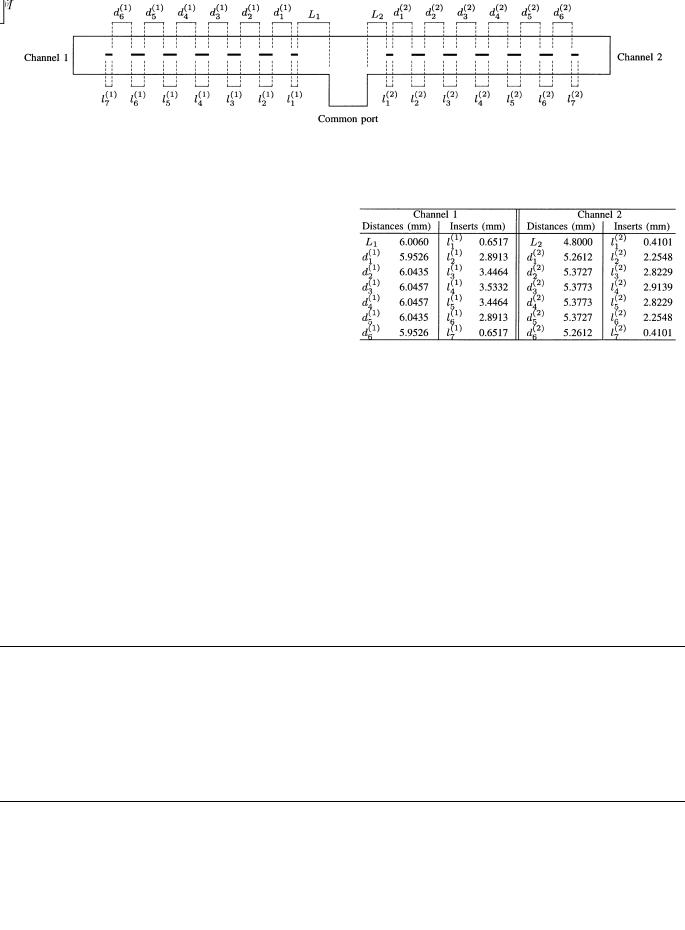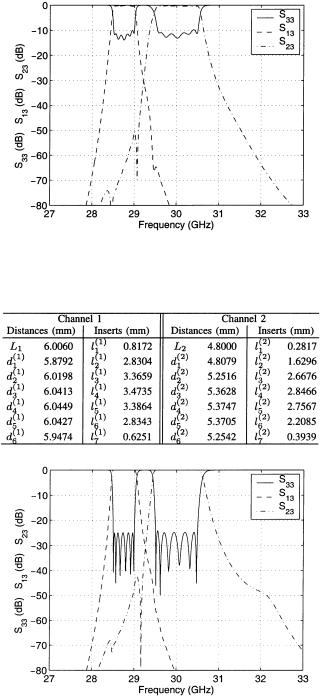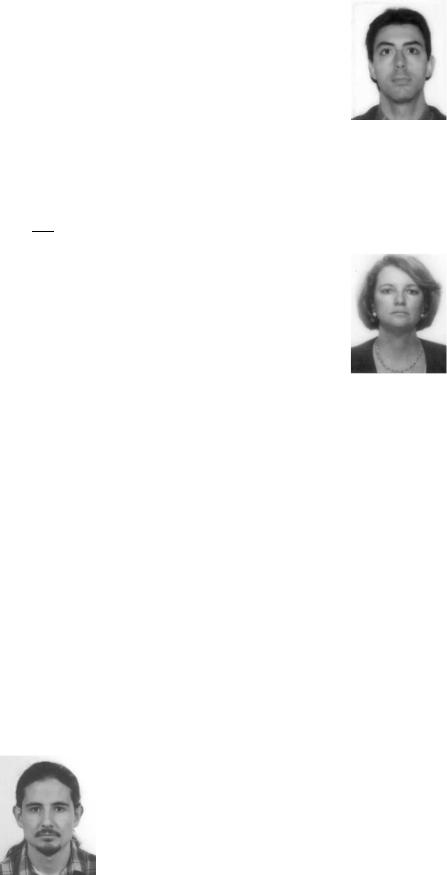
диафрагмированные волноводные фильтры / 5c4634c7-e678-4a23-ac92-4a1b852263ec
.pdf
518 |
IEEE TRANSACTIONS ON MICROWAVE THEORY AND TECHNIQUES, VOL. 52, NO. 2, FEBRUARY 2004 |
Fig. 9. Top view of a diplexer composed by two waveguide E-plane filters with all-metal inserts and an H-plane T-junction.
in Section III, where the vectors  ,
,  , and
, and  include the physical design parameters, the extracted circuital parameters, and the objective circuital parameters of both filters, respectively.
include the physical design parameters, the extracted circuital parameters, and the objective circuital parameters of both filters, respectively.
It should be noted that the objective coupling matrices are obtained from the ideal prototype filters that would have been used for optimization of the filters if they were isolated, instead of starting with the model of the complete diplexer structure as is usually done. In fact, the mutual interaction of both filters in the diplexer is reflected in the Jacobian matrix of the modeling function which cannot be almost diagonal, since the variation of the physical dimensions of one filter modifies the electromagnetic behavior of the other filter. Therefore, (30) must be used to calculate the initial Jacobian matrix. However, after this calculation, the Jacobian matrix is updated without additional evaluations of the modeling function, using the scheme of Section III-A.
The diplexer used to test the optimization method consists of two sixth-order  -plane filters connected by an
-plane filters connected by an  -plane T-junction as depicted in Fig. 9 with the following specifications:
-plane T-junction as depicted in Fig. 9 with the following specifications:
• Channel 1:
—center frequency: 28.75 GHz;
—bandwidth: 0.5 GHz;
—return loss in the passband: 25 dB.
• Channel 2:
—center frequency: 30 GHz;
—bandwidth: 1 GHz;
—return loss in the passband: 25 dB.
•Waveguide section: WR28 (7.112 mm  3.556 mm).
3.556 mm).
•Thickness of metal inserts: 100  m.
m.
TABLE III
INITIAL DESIGN PARAMETERS OF THE DIPLEXER
The initial design of the diplexer is synthesized following the method proposed in [24]. This method starts from the optimized design of the two filters and then fixes the distances from the reference planes of the T-junction to the reference plane of each filter (indicated as 
 and
and 
 in Fig. 9). The geometrical dimensions of the initial design are given in Table III, and the full-wave electromagnetic analyzed response of this initial design is shown in Fig. 10. The mutual interaction between the filters through the T-junction produces high return losses, as is observed in the response. The optimization method modifies the parameters of the filter in order to compensate for this mutual interaction and recover the frequency response of the isolated original filters. The process optimizes the couplings and the resonant frequencies of each filter, but not the distances between the filters and the T-junction (i.e.,
in Fig. 9). The geometrical dimensions of the initial design are given in Table III, and the full-wave electromagnetic analyzed response of this initial design is shown in Fig. 10. The mutual interaction between the filters through the T-junction produces high return losses, as is observed in the response. The optimization method modifies the parameters of the filter in order to compensate for this mutual interaction and recover the frequency response of the isolated original filters. The process optimizes the couplings and the resonant frequencies of each filter, but not the distances between the filters and the T-junction (i.e., 
 and
and 
 remain constant during the optimization routine).
remain constant during the optimization routine).
(43)
(44)

GARCÍA-LAMPÉREZ et al.: EFFICIENT EM OPTIMIZATION OF MICROWAVE FILTERS AND MULTIPLEXERS USING RATIONAL MODELS |
519 |
Fig. 10. Scattering parameters of the initial design of the diplexer.
TABLE IV
OPTIMIZED DESIGN PARAMETERS OF THE DIPLEXER
passband of each channel) were calculated in every electromagnetic simulation.
The second column of Table II shows the performance comparison of this process and the equivalent optimization using a conventional gradient-based method as in the example of the isolated filter. In this case, the optimum can be reached using both optimization techniques, but the computation time is reduced to only 0.83% using the proposed method. It should be noted the large reduction of the number of evaluated frequency sweeps due to the Jacobian update scheme, compared to the explicit computations of the gradient of the error function using a forward differences method.
V. CONCLUSION
In this paper, an efficient method for the direct electromagnetic optimization of microwave passive devices, based on the extraction of a rational model from a reduced number of data samples of the frequency response, has been described. Some particular advantages of this method is the possibility to approximate nonrational responses and the adaptive update of the mapping between the circuital model parameters and the dimensions of the physical device. The current implementation restricts the application of the method to lossless networks due to two limitations:
•the use of the lossless Feldtkeller equation;
•the analytical method used to synthesize a coupling matrix.
However, the usual approach for synthesizing microwave devices requires only the use of lossless models, as losses are introduced in a last step after the proper optimization.
Two numerical application examples have shown remarkable improvements in computation efficiency. This reduction of the total time required for the optimization is achieved in two ways. First, the number of required optimization iterations is greatly reduced. Second, the number of needed data samples at each iteration is minimized thanks to the use of Cauchy’s method. One of the examples consists of the optimization of a complete diplexer, showing the flexibility of the method, that can be applied to structures different from isolated filters.
Fig. 11. Scattering parameters of the optimized design of the diplexer.
The geometric dimensions after optimizing the diplexer are shown in Table IV, and the scattering parameters of the modified design are presented in Fig. 11, where the equiripple response is almost completely recovered. As expected, the most modified geometrical dimensions are those located closer to the T-junc- tion, in order to compensate the reactive load that each filter presents to the other. The complete optimization process of the 26 parameters took only ten iterations and the total number of full-wave electromagnetic simulations executed was 37 (11 for the initial design and the ten iterations and 2  13 for the computation of the initial Jacobian, since there are 13 geometrical parameters in each filter). Only 22 frequency samples (11 in the
13 for the computation of the initial Jacobian, since there are 13 geometrical parameters in each filter). Only 22 frequency samples (11 in the
REFERENCES
[1]J. Herbert and L. Thal, “Computer-aided filter alignment and diagnosis,”
IEEE Trans. Microwave Theory Tech., vol. MTT-26, pp. 958–963, Dec. 1978.
[2]M. Bakr, J. Bandler, N. Georgieva, and K. Madsen, “A hybrid aggressive space-mapping algorithm for EM optimization,” IEEE Trans. Microwave Theory Tech., vol. 47, pp. 2440–2449, Dec. 1999.
[3]S. Bila, D. Baillargeat, M. Aubourg, S. Verdeyme, P. Guillon, F. Seyfert, J. Grimm, L. Baratchart, C. Zanchi, and J. Sombrin, “Direct electromagnetic optimization of microwave filters,” IEEE Microwave Mag., vol. 2, pp. 46–51, Mar. 2001.
[4]M. Kahrizi, S. Safavi-Naeini, S. K. Chaudhuri, and R. Sabry, “Computer diagnosis and tuning of RF and microwave filters using model-based parameter estimation,” IEEE Trans. Circuits Syst., vol. 49, pp. 1263–1270, Sept. 2002.
[5]P. Harscher, R. Vahldieck, and S. Amari, “Automated filter tuning using generalized low-pass prototype networks and gradient-based parameter extraction,” IEEE Trans. Microwave Theory Tech., vol. 49, pp. 2532–2538, Dec. 2001.
[6]A. E. Atia and H.-W. Yao, “Tuning and measurements of couplings and resonant frequencies for cascaded resonators,” in Proc. IEEE MTT-S Int. Microwave Symp., vol. 3, Boston, MA, June 2000, pp. 1637–1640.

520 |
IEEE TRANSACTIONS ON MICROWAVE THEORY AND TECHNIQUES, VOL. 52, NO. 2, FEBRUARY 2004 |
[7]A. García Lampérez, M. Salazar Palma, M. Padilla, and I. Hidalgo Carpintero, “Software tool for the design of narrow band band-pass filters,” in Proc. IEEE MTT-S Int. Microwave Symp., vol. 3, Phoenix, AZ, May 2001, pp. 2103–2106.
[8]K. Kottapalli, T. K. Sarkar, Y. Hua, E. K. Miller, and G. J. Burke, “Accurate computation of wide-band response of electromagnetic systems utilizing narrow-band information,” IEEE Trans. Microwave Theory Tech., vol. 39, pp. 682–687, Apr. 1991.
[9]R. S. Adve and T. K. Sarkar, “Generation of accurate broadband information from narrowband data using the Cauchy method,” Microwave Opt. Technol. Lett., vol. 6, no. 10, pp. 569–573, Aug. 1993.
[10]S. F. Peik, R. R. Mansour, and Y. L. Chow, “Multidimensional Cauchy method and adaptive sampling for an accurate microwave circuit modeling,” IEEE Trans. Microwave Theory Tech., vol. 46, pp. 2364–2371, Dec. 1998.
[11]A. García Lampérez, T. K. Sarkar, and M. Salazar Palma, “Robust computation and modeling of wide-band system responses using the Cauchy method,” in Proc. IEEE Antennas and Propagation Soc. Int. Symp., vol. 2, San Antonio, TX, June 2002, pp. 720–723.
[12], “Filter model generation from scattering parameters using the Cauchy method,” in Proc. 32nd Eur. Microwave Conf., vol. 1, Milan, Italy, Sept. 2002, pp. 413–416.
[13]S. Amari and J. Bornemann, “Maximum number of finite transmission zeros of coupled resonator filters with source/load-multiresonator coupling and a given topology,” in Proc. 2000 Asia–Pacific Microwave Conf., Sydney, Australia, 2000, pp. 1175–1177.
[14]R. J. Cameron, “General coupling matrix synthesis methods for Chebyshev filtering functions,” IEEE Trans. Microwave Theory Tech., vol. 47, pp. 433–442, Apr. 1999.
[15]C. G. Broyden, “A class of methods for solving nonlinear simultaneous equations,” Math. Comput., vol. 19, no. 92, pp. 577–593, Oct. 1965.
[16]E. K. Miller and T. K. Sarkar, “Model-order reduction in electromagnetics using model-based parameter estimation,” in Frontiers in Electromagnetics. Piscataway, NJ: IEEE Press, 1999, pp. 371–436.
[17]S. Van Huffel and J. Vandewalle, The Total Least Squares Problem: Computational Aspects and Analysis. Philadelphia, PA: SIAM, 1991.
[18]A. Edelman and H. Murakami, “Polynomial roots from companion matrix eigenvalues,” Math. Comput., vol. 64, no. 210, pp. 763–776, 1995.
[19]A. E. Atia and A. E. Williams, “Narrow-bandpass waveguide filters,”
IEEE Trans. Microwave Theory Tech., vol. MTT-20, pp. 258–265, Apr. 1972.
[20]A. E. Atia, A. E. Williams, and R. W. Newcomb, “Narrow-band multiple coupled cavity synthesis,” IEEE Trans. Circuits Syst., vol. CAS-20, pp. 649–655, Sept. 1974.
[21]R. J. Cameron, “Advanced coupling matrix synthesis techniques for microwave filters,” IEEE Trans. Microwave Theory Tech., vol. 51, pp. 1–10, Jan. 2003.
[22]D. Budimir, Generalized Filter Design by Computer Optimization. Boston, MA: Artech House, 1998.
[23]Y. Rong, H. Wen Yao, K. A. Zaki, and T. G. Dolan, “Millimeter-wave Ka-band H-plane diplexers and multiplexers,” IEEE Trans. Microwave Theory Tech., vol. 47, pp. 2325–2330, Dec. 1999.
[24]A. Morini and T. Rozzi, “Constraints to the optimum performance and bandwidth limitations of diplexers employing symmetric three-port junctions,” IEEE Trans. Microwave Theory Tech., vol. 44, pp. 242–248, Feb. 1996.
Alejandro García-Lampérez (S’98) was born in Madrid, Spain, in 1976. He received the Ingeniero de Telecomunicación (M.S.E.E.) degree from the Universidad Politécnica de Madrid (UPM), Madrid, Spain, in 2000, and is currently working toward the Ph.D. degree at the UPM.
Since September 1999, he has been with the Microwave and Radar Group, Departamento de Señales, Sistemas y Radiocomunicaciones (SSR), UPM, where he carried out his graduate work on techniques for the design of microwave filters. His
research activities and interests are in the area of passive microwave devices design and simulation and application of numerical methods to electromagnetic problems.
Sergio Llorente-Romano (S’01) was born in Madrid, Spain, in 1977. He received the Ingeniero de Telecomunicacíon (M.S.E.E.) degree from the Universidad Politécnica de Madrid (UPM), Madrid, Spain, in 2000, and is currently working toward the Ph.D. degree at UPM.
Since September 1999, he has been with the Microwave and Radar Group, Departamento de Señales, Sistemas y Radiocomunicaciones (SSR), UPM, where he carried out his graduate work on techniques for the simulation and design of filters
and diplexers in waveguide technology. His research activities and interests are in the area of numerical methods applied to electromagnetic problems related to the design of microwave devices.
Magdalena Salazar-Palma (M’89–SM’01) was born in Granada, Spain. She received the Ingeniero de Telecomunicación and Ph.D. degrees from the Universidad Politécnica de Madrid (UPM), Madrid, Spain.
She is currently a Profesor Titular with the Departamento de Señales, Sistemas y Radiocomunicaciones, Escuela Técnica Superior de Ingenieros de Telecomunicación, UPM. She has taught courses on electromagnetic-field theory, microwave and antenna theory, circuit networks and filter theory, analog and
digital communication systems theory, numerical methods for electromagneticfield problems, as well as related laboratories. She has developed her research within the Grupo de Microondas y Radar in the areas of electromagnetic-field theory, computational and numerical methods for microwave structures, passive components, and antenna analysis; design, simulation, optimization, implementation, and measurements of hybrid and monolithic microwave integrated circuits; and network and filter theory and design. On numerous occasions, she has been a Visiting Professor with the Department of Electrical Engineering and Computer Science, Syracuse University, Syracuse, NY. She has authored three books and has authored or coauthored a total of 15 contributions for chapters and papers in books published internationally, 30 papers in international journals, and 140 papers in international conferences, symposiums, and workshops, plus a number of national publications and reports. She has served in different academic committees at the department, school, and university level. She has delivered a number of invited presentations, lectures, and seminars. She has lectured on several short courses, some of them in the frame of European Community Programs. She has participated as a researcher or director in 45 research projects and contracts, financed by international, European, and national institutions and companies. She has assisted the Comisión Interministerial de Ciencia y Tecnología (Spain National Board of Research) in the evaluation of projects. She is serving as reviewer of the Grant Project Office of the Italian Ministero dell’Universita e della Ricerca Scientifica e Tecnologica (Ministry of Universities and Scientific and Technological Research). She has also served in several evaluation panels of the Commission of the European Communities. She was Topical Editor for the disk of references of the triennial Review of Radio Science for three times. She has been a member of the Editorial Board of three scientific journals.
Prof. Salazar-Palma is a Registered Ingeniero de Telecomunicación in Spain. She is an associate editor for the IEEE ANTENNAS AND WIRELESS PROPAGATION LETTERS (AWPL). She is a correspondent of the International Union of Radio Science (URSI). She has served as vice-chairman and chairman of the IEEE Microwave Theory and Techniques Society (IEEE MTT-S)/IEEE Antennas and Propagation Society (IEEE AP-S) Spain joint chapter and chairman of the IEEE Spain Section. She is currently the IEEE Spain Section membership development officer. She has been a member of the IEEE Region 8 Nominations and Appointments Committee. She is currently the chairperson of the IEEE Region 8 Conference Coordination Subcommittee. She has been a member of the IEEE Ethics and Member Conduct Committee. Since 2001, she has been a member of the IEEE Women in Engineering Committee (WIEC). She has acted as liaison between the IEEE Regional Activities Board and the IEEE WIEC. She is currently the chairperson of the IEEE WIEC. She is a member of the Technical Program Committee of several international and national symposiums and reviewer for different international scientific journals, symposiums, and editorial companies. She has received two individual research awards and, together with the rest of her department, another research award, all from national institutions.

GARCÍA-LAMPÉREZ et al.: EFFICIENT EM OPTIMIZATION OF MICROWAVE FILTERS AND MULTIPLEXERS USING RATIONAL MODELS |
521 |
Tapan K. Sarkar (S’69–M’76–SM’81–F’92) received the B.Tech. degree from the Indian Institute of Technology, Kharagpur, India, in 1969, the M.Sc.E. degree from the University of New Brunswick, Fredericton, NB, Canada, in 1971, and the M.S. and Ph.D. degrees from Syracuse University, Syracuse, NY, in 1975.
From 1975 to 1976, he was with the TACO Division, General Instruments Corporation. He was with the Rochester Institute of Technology, Rochester, NY, from 1976 to 1985. He was a
Research Fellow with the Gordon McKay Laboratory, Harvard University, Cambridge, MA, from 1977 to 1978. He is currently a Professor with the Department of Electrical and Computer Engineering, Syracuse University. His current research interests deal with numerical solutions of operator equations arising in electromagnetics and signal processing with application to system design. He has authored or coauthored over 250 journal papers and numerous conference papers and has authored 28 chapters in books and ten books, including Iterative and Self Adaptive Finite-Elements in Electromagnetic Modeling (Boston, MA: Artech House, 1998), Applications of Wavelets in Electromagnetic and Signal Analysis (Boston, MA: Artech House, 2002), and
Smart Antennas (New York: Wiley/IEEE Press, 2003). He is on the editorial board of Journal of Electromagnetic Waves and Applications and Microwave and Optical Technology Letters.
Dr. Sarkar is a Registered Professional Engineer in the State of New York. He is a member of Sigma Xi and International Union of Radio Science Commissions A and B. He was an associate editor for feature articles of the IEEE Antennas and Propagation Society Newsletter, and he was the Technical Program chairman for the 1988 IEEE Antennas and Propagation Society International Symposium and URSI Radio Science Meeting. He has been appointed a U.S. Research Council Representative to many URSI General Assemblies. He was the Chairman of the Intercommission Working Group of International URSI on Time Domain Metrology (1990–1996). He was the recipient of the Best Paper Award of the IEEE TRANSACTIONS ON ELECTROMAGNETIC COMPATIBILITY in 1979 and at the 1997 National Radar Conference. He received the College of Engineering Research Award in 1996 and the Chancellor’s Citation for Excellence in Research in 1998 at Syracuse University. He received the title Docteur Honoris Causa from Universite Blaise Pascal, Clermont Ferrand, France in 1998 and the Medal of the City of Clermont Ferrand, France, in 2000.
